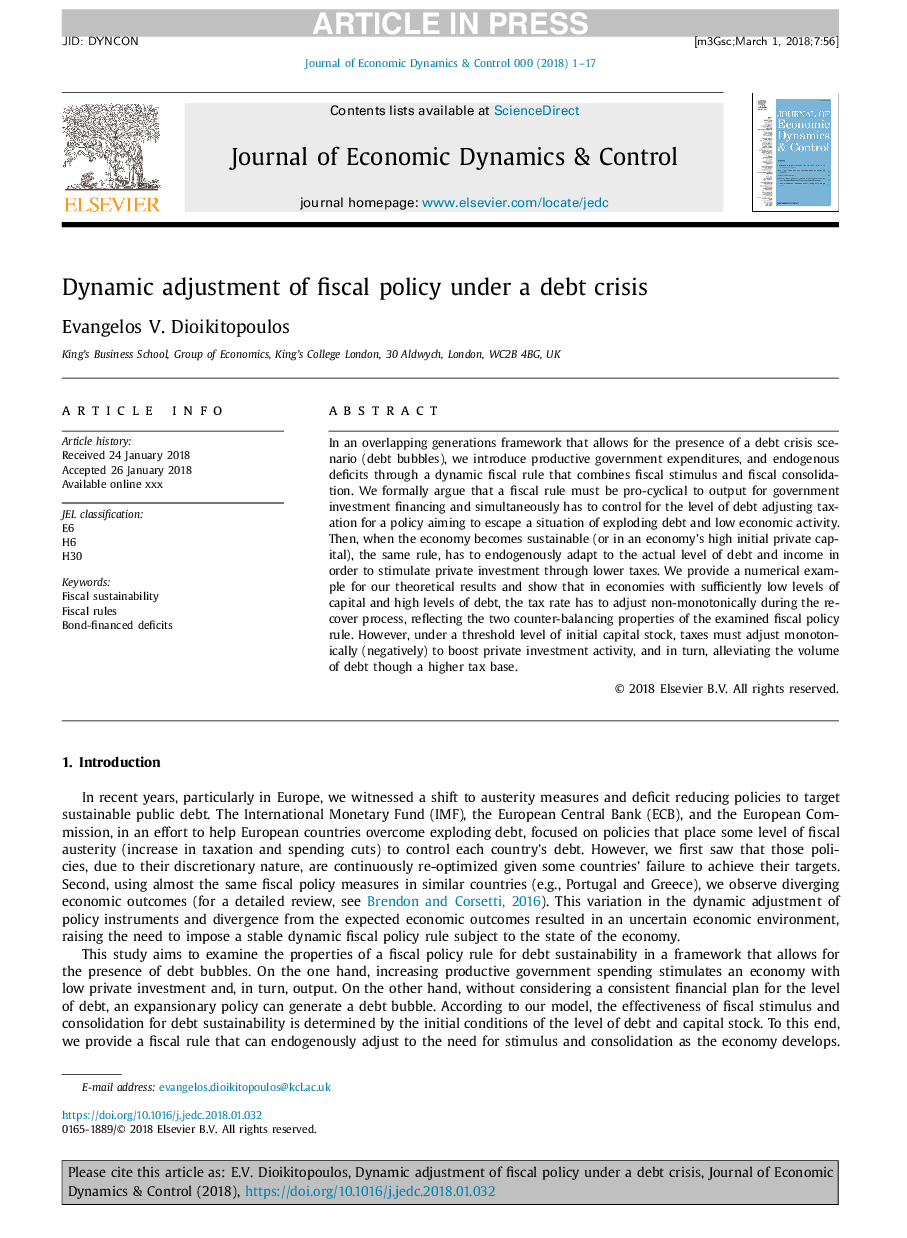| کد مقاله | کد نشریه | سال انتشار | مقاله انگلیسی | نسخه تمام متن |
|---|---|---|---|---|
| 7358474 | 1478652 | 2018 | 17 صفحه PDF | دانلود رایگان |
عنوان انگلیسی مقاله ISI
Dynamic adjustment of fiscal policy under a debt crisis
ترجمه فارسی عنوان
تعدیل دینامیک سیاست مالی تحت یک بحران بدهی
دانلود مقاله + سفارش ترجمه
دانلود مقاله ISI انگلیسی
رایگان برای ایرانیان
ترجمه چکیده
در یک چارچوب نسلهای همپوشانی که اجازه حضور سناریوهای بحران بدهی (حباب بدهی) را می دهد، هزینه های دولتی تولیدی و نقص های درونی را از طریق قانون مالی پویا که ترکیبی از محرک های مالی و تثبیت مالی است، معرفی می کنیم. ما به طور رسمی استدلال می کنیم که یک قاعده مالی باید برای تامین مالی سرمایه گذاری های دولتی به طور غیرمستقیم به کار گرفته شود و به طور همزمان باید سطح مالیات بر تنظیم بدهی را برای یک سیاست جهت فرار از وضعیت انفجار بدهی و فعالیت اقتصادی کم، کنترل کند. سپس، زمانی که اقتصاد پایدار می شود (یا در یک سرمایه خصوصی اولیه اولیه اقتصادی)، همان قاعده، باید در درون سازگاری با میزان واقعی بدهی و درآمد به منظور تحریک سرمایه گذاری خصوصی از طریق مالیات پایین تر. ما یک مثال عددی برای نتایج نظری ما ارائه می دهیم و نشان می دهیم که در اقتصادهایی با سطوح پایین سرمایه و سطوح بالای بدهی، نرخ مالیات باید در طول فرآیند بازیابی غیرمنتظره تنظیم شود، که منعکس کننده دو ویژگی متعادل کننده ی مورد بررسی قانون سیاست مالی با این حال، تحت یک سطح آستانه سهام اولیه، مالیات ها باید به صورت یکنواخت (منفی) برای تقویت فعالیت سرمایه گذاری خصوصی، و به نوبه خود، کاهش میزان بدهی، هرچند یک مبنای مالیات بالاتر.
موضوعات مرتبط
مهندسی و علوم پایه
ریاضیات
کنترل و بهینه سازی
چکیده انگلیسی
In an overlapping generations framework that allows for the presence of a debt crisis scenario (debt bubbles), we introduce productive government expenditures, and endogenous deficits through a dynamic fiscal rule that combines fiscal stimulus and fiscal consolidation. We formally argue that a fiscal rule must be pro-cyclical to output for government investment financing and simultaneously has to control for the level of debt adjusting taxation for a policy aiming to escape a situation of exploding debt and low economic activity. Then, when the economy becomes sustainable (or in an economy's high initial private capital), the same rule, has to endogenously adapt to the actual level of debt and income in order to stimulate private investment through lower taxes. We provide a numerical example for our theoretical results and show that in economies with sufficiently low levels of capital and high levels of debt, the tax rate has to adjust non-monotonically during the recover process, reflecting the two counter-balancing properties of the examined fiscal policy rule. However, under a threshold level of initial capital stock, taxes must adjust monotonically (negatively) to boost private investment activity, and in turn, alleviating the volume of debt though a higher tax base.
ناشر
Database: Elsevier - ScienceDirect (ساینس دایرکت)
Journal: Journal of Economic Dynamics and Control - Volume 93, August 2018, Pages 260-276
Journal: Journal of Economic Dynamics and Control - Volume 93, August 2018, Pages 260-276
نویسندگان
Evangelos V. Dioikitopoulos,
